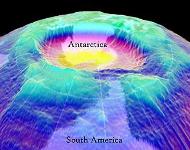Climate Change Impacts Linked to Ozone Depletion
 “A warming world with violent storms holds many unpleasant surprises” said Durwood Zaelke, President of the Institute for Governance and Sustainable Development (IGSD).
“A warming world with violent storms holds many unpleasant surprises” said Durwood Zaelke, President of the Institute for Governance and Sustainable Development (IGSD). “Recent research now suggests that this may include damage to the protective ozone shield, which protects us from harmful ultraviolet radiation that causes skin cancer, cataracts, suppresses the human immune system, and damages crops and ecosystems.”
“Protecting the stratospheric ozone layer is a job that the Montreal Protocol has done for the last 25 years, putting the ozone layer on a course of recovery by mid-century,” Zaelke continued.
The new challenge is the surprise finding in a recently published Harvard University study that increasing climate-driven summer thunderstorms might inject more water into the stratosphere, which has the potential to damage the protective ozone layer over the United States and possibly other parts of the globe.
This study is one of the first to hypothesize that climate change could reduce stratospheric ozone over populated areas. If they prove correct, depletion of the ozone layer will increase if global warming leads to more such storms.
In the stratosphere when temperatures are very low, increasing water vapor releases chlorine residing in inactive forms, mimicking processes that cause the ‘ozone hole’ over Antarctica.
While ozone depletion from storms in midlatitude regions like the US has not been reported so far, the study concludes that if the intensity and frequency of the convective injecting storms were to increase as a result of climate change, increased risk of ozone depletion and associated increases in ultraviolet exposure could follow. To confirm and quantify the risk, more detailed modeling of storms and the response of ozone to water vapor injections in the stratosphere is needed.
“The most surprising aspect is that this potential impact of climate on stratospheric ozone was not anticipated,”stated Stephen O. Andersen, Director of Research at IGSD. “This new research brings back into play the ‘precautionary principal’ of global environmental protection that justifies action before the science is resolved if delay would make solutions too expensive or too late to protect the earth for future generations.
Taking fast action to reduce short-lived climate pollutants (SLCPs) including black carbon, methane, tropospheric ozone and hydrofluorocarbons (HFCs), is a critical climate strategy which can reduce the possibility that severe storms will inject more water vapor into the stratosphere.
Reducing SLCPs could cut the rate of global warming in half for the next several decades, cut the rate of warming over the elevated regions of the Himalayas and Tibet by at least half, and the rate of warming in the Arctic by two-thirds over the next 30 years. Since many SLCPs are also potent air pollutants cutting them can also prevent up to 4.7 million premature deaths each year and prevent billions of dollars in crop losses.
“The possibility of significant ozone depletion over North America is only the newest in a litany of accelerating impacts of climate change,” stated Durwood Zaelke, President of IGSD. “We cannot afford to wait to take fast-action.”
You can return to the main Market News page, or press the Back button on your browser.

